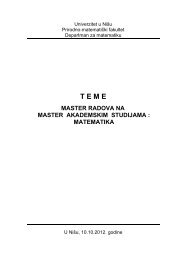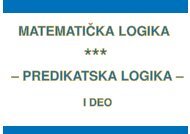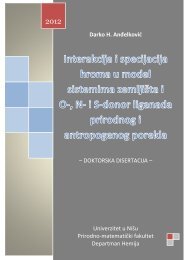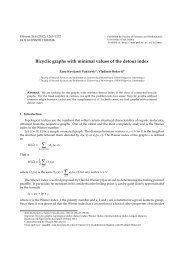An iterative algorithm to compute the Bott-Duffin inverse and ...
An iterative algorithm to compute the Bott-Duffin inverse and ...
An iterative algorithm to compute the Bott-Duffin inverse and ...
Create successful ePaper yourself
Turn your PDF publications into a flip-book with our unique Google optimized e-Paper software.
Filomat 26:4 (2012), 769–776<br />
DOI 10.2298/FIL1204769S<br />
Published by Faculty of Sciences <strong>and</strong> Ma<strong>the</strong>matics,<br />
University of Niˇs, Serbia<br />
Available at: http://www.pmf.ni.ac.rs/filomat<br />
<strong>An</strong> <strong>iterative</strong> <strong>algorithm</strong> <strong>to</strong> <strong>compute</strong> <strong>the</strong> <strong>Bott</strong>-<strong>Duffin</strong> <strong>inverse</strong> <strong>and</strong><br />
generalized <strong>Bott</strong>-<strong>Duffin</strong> <strong>inverse</strong><br />
Xingping Sheng a<br />
a School of Ma<strong>the</strong>matics <strong>and</strong> Computational Science in Fuyang Normal College, Fuyang <strong>An</strong>hui, P.R. China<br />
Abstract. Let L be a subspace of C n <strong>and</strong> PL be <strong>the</strong> orthogonal projec<strong>to</strong>r of C n on<strong>to</strong> L. For A ∈ C n×n , <strong>the</strong><br />
generalized <strong>Bott</strong>-<strong>Duffin</strong> (B-D) <strong>inverse</strong> A (†)<br />
(L)<br />
is given by A(†)<br />
(L) = PL(APL + PL ⊥)† . In this paper, by defined a non-<br />
st<strong>and</strong>ard inner product, a finite formulae is presented <strong>to</strong> <strong>compute</strong> <strong>Bott</strong>-<strong>Duffin</strong> <strong>inverse</strong> A (−1)<br />
(L)<br />
= PL(APL+PL ⊥)−1<br />
<strong>and</strong> generalized <strong>Bott</strong>-<strong>Duffin</strong> <strong>inverse</strong> A (†)<br />
(L) = PL(APL+PL ⊥)† under <strong>the</strong> condition A is L−zero (i.e., AL∩L ⊥ = {0}).<br />
By this <strong>iterative</strong> method, when taken <strong>the</strong> initial matrix X0 = PLA ∗ PL, <strong>the</strong> <strong>Bott</strong>-duffin <strong>inverse</strong> A (−1)<br />
(L) <strong>and</strong><br />
generalized <strong>Bott</strong>-duffin <strong>inverse</strong> A (†)<br />
can be obtained within a finite number of iterations in absence of<br />
(L)<br />
roundoff errors. Finally a given numerical example illustrates that <strong>the</strong> <strong>iterative</strong> <strong>algorithm</strong> dose converge.<br />
1. Introduction<br />
The <strong>Bott</strong>-<strong>Duffin</strong> (B-D) <strong>inverse</strong> was first introduced by <strong>Bott</strong> <strong>and</strong> <strong>Duffin</strong> in <strong>the</strong>ir famous paper [2]. Many<br />
properties <strong>and</strong> applications of <strong>the</strong> B-D <strong>inverse</strong> have been developed in [1, 11]. Later, Chen in his paper [5]<br />
defined <strong>the</strong> generalized B-D <strong>inverse</strong> of a square matrix <strong>and</strong> gave some properties <strong>and</strong> applications. Wang<br />
<strong>and</strong> Wei in [10] <strong>and</strong> Wei <strong>and</strong> Xu in [12] discussed <strong>the</strong> perturbation <strong>the</strong>ory for <strong>the</strong> B-D <strong>inverse</strong> <strong>and</strong> showed<br />
<strong>the</strong> B-D condition number KBD(A) =∥ A ∥ · ∥ A (−1)<br />
∥ <strong>to</strong> be minimum in <strong>the</strong> inequality of error analysis<br />
(L)<br />
<strong>and</strong> <strong>the</strong> perturbation bound of <strong>the</strong> solution of <strong>the</strong> constrained system. Recently, in [6], Liu et al. use <strong>the</strong><br />
projection methods, which is an applications of <strong>the</strong> generalization of <strong>the</strong> <strong>Bott</strong>-<strong>Duffin</strong> <strong>inverse</strong>, for solving<br />
sparse linear systems. Chen et al. in [3, 4], Xue <strong>and</strong> Chen in [13], <strong>and</strong> Zhang et al. in [14], established <strong>the</strong><br />
under L− zero matrices, presented <strong>the</strong> expression<br />
perturbation <strong>the</strong>ory of <strong>the</strong> generalized B-D <strong>inverse</strong> A †<br />
(L)<br />
of A †<br />
(L)<br />
<strong>and</strong> point <strong>the</strong> A† under L− zero matrices popularize that in [5].<br />
(L)<br />
The authors also did some works on <strong>the</strong> computation of generalized <strong>inverse</strong>s. In [8], <strong>the</strong> authors gave a<br />
. In [9], <strong>the</strong>y obtain a representation of<br />
full-rank representation <strong>and</strong> <strong>the</strong> minor of <strong>the</strong> generalized <strong>inverse</strong> A (2)<br />
T,S<br />
A (2)<br />
T,S<br />
based on Gaussian elimination. Until now, we could not see using finite <strong>iterative</strong> <strong>algorithm</strong> <strong>to</strong> <strong>compute</strong><br />
<strong>the</strong> B-D <strong>inverse</strong> <strong>and</strong> generalized B-D <strong>inverse</strong>. In this paper, we will first introduce a non-st<strong>and</strong>ard inner<br />
product <strong>and</strong> <strong>the</strong>n develop a finite <strong>iterative</strong> formulae for <strong>the</strong> <strong>the</strong> <strong>Bott</strong>-duffin <strong>inverse</strong> A (−1)<br />
<strong>and</strong> generalized<br />
(L)<br />
2010 Ma<strong>the</strong>matics Subject Classification. Primary 15A09; Secondary 15A03, 15A24<br />
Keywords. <strong>Bott</strong>-<strong>Duffin</strong> <strong>inverse</strong>, generalized <strong>Bott</strong>-<strong>Duffin</strong> <strong>inverse</strong>, <strong>iterative</strong> method, orthogonal projection<br />
Received: 21 December 2011; Accepted: 20 April 2012<br />
Communicated by Y. Wei<br />
This project was supported by NSF China (no.11071079), <strong>An</strong>hui Provincial Natural Science Foundation (no.10040606Q47), <strong>and</strong><br />
The University Natural Science Research key Project of <strong>An</strong>hui Province (no. KJ2010A253)<br />
Email address: xingpingsheng@163.com (Xingping Sheng)
X. Sheng / Filomat 26:4 (2012), 769–776 770<br />
<strong>Bott</strong>-duffin <strong>inverse</strong> A (†)<br />
. In <strong>the</strong> end of <strong>the</strong> paper, a numerical example demonstrate that <strong>the</strong> <strong>iterative</strong> method<br />
(L)<br />
is quite efficient.<br />
2. Notations <strong>and</strong> preliminaries<br />
Throughout <strong>the</strong> paper, let C n×n (resp. C m×n ) denote <strong>the</strong> set of all n × n (resp. m × n) matrices over C.<br />
L is a subspace of C n <strong>and</strong> PL is <strong>the</strong> orthogonal projec<strong>to</strong>r on<strong>to</strong> L. For any A ∈ C n×n , we write R(A) for its<br />
range, N(A) for its nullspace. A ∗ <strong>and</strong> r(A) st<strong>and</strong> for <strong>the</strong> conjugate transpose <strong>and</strong> <strong>the</strong> rank of A, respectively.<br />
Recall that <strong>the</strong> <strong>Bott</strong>-<strong>Duffin</strong> <strong>inverse</strong> of A ∈ C n×n is <strong>the</strong> matrix by A (−1)<br />
(L) = PL(APL + PL ⊥)−1 = (PLAPL) † when<br />
APL + PL⊥ is nonsingular. The generalized <strong>Bott</strong>-<strong>Duffin</strong> <strong>inverse</strong> of A is A(†)<br />
(L) = PL(APL + PL⊥)† . When A is<br />
L-zero A (†)<br />
(L) = (PLAPL) † .<br />
Let L be a subspace of C n , The restricted conjugate transpose on L of a complex matrix A is defined as<br />
A ∗<br />
L = PLA ∗ PL. In <strong>the</strong> same way, in <strong>the</strong> space C n×n , a restricted inner product on <strong>the</strong> subspace L is defined as<br />
< A, B >L=< PLAPL, B >= tr(PLA ∗ PLB) for all A, B ∈ C n×n , which is called non-st<strong>and</strong>ard inner product. Then<br />
<strong>the</strong> restricted norm on L of a matrix A generated by this inner product is <strong>the</strong> Frobenius norm of <strong>the</strong> matrix<br />
PLAPL denoted by ∥ A ∥L.<br />
For a complex matrix A ∈ C m×n , <strong>the</strong> Moore-Penrose <strong>inverse</strong> A † is defined <strong>to</strong> be unique solution of <strong>the</strong><br />
following four Penrose equations<br />
(1) AXA = A, (2) XAX = X, (3) (AX) ∗ = AX, (4) (XA) ∗ = XA.<br />
A matrix X is called {i, j, . . . , k} <strong>inverse</strong> of A if it satisfies (i), (j), . . . , (k) from among <strong>the</strong> equations (1) − (4).<br />
The {2} <strong>inverse</strong> of a matrix A ∈ C m×n with range T <strong>and</strong> nullspace S is defined as following:<br />
Let A ∈ C m×n be of rank r, T be a subspace of C n of dimension s ≤ r <strong>and</strong> S be a subspace of C m of<br />
dimension m − s. If X satisfies XAX = X, R(X) = T <strong>and</strong> N(X) = S, <strong>the</strong>n X is called <strong>the</strong> generalized <strong>inverse</strong><br />
A (2)<br />
T,S<br />
of A. When s = r, A(2)<br />
T,S<br />
= A(1,2)<br />
T,S .<br />
In this paper <strong>the</strong> following Lemmas are needed in what follows:<br />
Lemma 2.1. ([1]) Let A ∈ C m×n be of rank r, any two of <strong>the</strong> following three statements imply <strong>the</strong> third:<br />
X ∈ A{1}<br />
X ∈ A{2}<br />
rankA = rankX.<br />
Lemma 2.2. ([1]) Let A ∈ C n×n , L be a subspace of C n . If APL + PL⊥ is nonsingular, <strong>the</strong>n<br />
(1) A (−1)<br />
(L)<br />
(2) (A (−1)<br />
(L) )(−1)<br />
(L)<br />
= (APL) (1,2)<br />
L,L ⊥ = (PLA) (1,2)<br />
L,L ⊥ = (PLAPL) (1,2)<br />
L,L ⊥ ,<br />
= PLAPL.<br />
Lemma 2.3. ([4]) Let L be a subspace of C n with dimL = k ≤ r(A) <strong>and</strong> let <strong>the</strong> columns of n × k matrix U form an<br />
orthogonal basis for L. The following statements are equivalent:<br />
(1) AL ∩ L ⊥ = {0}, i.e., A is L-zero;<br />
(2) N(A) ∩ L = N(AL), i.e., N(PLAPL) = N(APL);<br />
(3) A (†)<br />
(L) = (PLAPL) † = (PLAPL) (1,2)<br />
R(PLA ∗ PL),N(PLA ∗ PL) ;<br />
(4) r(AU) = r(U ∗ AU).<br />
Lemma 2.4. ([1]) Let L <strong>and</strong> M be complementary subspaces of C n , <strong>the</strong> projec<strong>to</strong>r PL,M has <strong>the</strong> following properies<br />
(1) PL,MA = A if <strong>and</strong> only if R(A) ⊂ L ,<br />
(2) APL,M = A if <strong>and</strong> only if N(A) ⊃ M.<br />
Throughout <strong>the</strong> paper, we assume that APL + PL ⊥ is nonsingular or AL ∩ L⊥ = {0} (i.e., A is L-zero).<br />
About <strong>the</strong> restricted inner product on subspace L, we have <strong>the</strong> following property.
Lemma 2.5. Let L be <strong>the</strong> subspace of C n , A, B ∈ C n×n , <strong>the</strong>n we have:<br />
X. Sheng / Filomat 26:4 (2012), 769–776 771<br />
< A, B >L=< A, PLBPL >=< PLAPL, BPL >= < B, A >L =< B ∗ , PLA ∗ PL > .<br />
According <strong>to</strong> <strong>the</strong> definition <strong>and</strong> <strong>the</strong> properties of inner product, <strong>the</strong> above equalities are right.<br />
3. Iterative method for computing A (†)<br />
<strong>and</strong> A(−1)<br />
(L) (L)<br />
In this section we first introduce an <strong>iterative</strong> method <strong>to</strong> obtain a solution of <strong>the</strong> matrix equation<br />
PLAXAPL = PLAPL, where A ∈ Cn×n . We <strong>the</strong>n show that if APL + PL⊥ is nonsingular or APL + PL⊥ is<br />
singular but A is L-zero, <strong>the</strong>n for any initial matrix X0 with R(X0) ⊂ PLA∗ , <strong>the</strong> matrix sequence {Xk} generated<br />
by <strong>the</strong> <strong>iterative</strong> method converges <strong>to</strong> its a solution within at most n2 iteration steps in absence of <strong>the</strong><br />
roundoff errors. We also show that if let <strong>the</strong> initial matrix X0 = PLA∗PL, <strong>the</strong>n <strong>the</strong> solution X∗ obtained by<br />
<strong>the</strong> <strong>iterative</strong> method is <strong>the</strong> generalized <strong>Bott</strong>-<strong>Duffin</strong> <strong>inverse</strong> A (†)<br />
(L) .<br />
First we present <strong>the</strong> iteration method for solving <strong>the</strong> matrix equation PLAXAPL = PLAPL, <strong>the</strong> iteration<br />
method as follows:<br />
Algorithm 3.1:<br />
1. Input matrices A ∈ C n×n , PL ∈ C n×n <strong>and</strong> X0 ∈ C n×n with R(X0) ⊂ R(PLA ∗ );<br />
2. Calculate<br />
R0 = A − AX0A; P0 = A(R0) ∗<br />
LA; k := 0.<br />
3. If PLRk = 0, <strong>the</strong>n s<strong>to</strong>p; o<strong>the</strong>rwise, k := k + 1;<br />
4. Calculate<br />
Xk = Xk−1 + ∥ Rk−1 ∥2 L<br />
∥ Pk−1 ∥2 L<br />
(Pk−1) ∗<br />
L ;<br />
Rk = A − AXkA = Rk−1 − ∥ Rk−1 ∥2 L<br />
∥ Pk−1 ∥2 L<br />
Pk = A(Rk) ∗<br />
LA + ∥ Rk ∥2 L<br />
∥ Rk−1 ∥2 Pk−1;<br />
5. Go<strong>to</strong> step 3.<br />
L<br />
A(Pk−1) ∗<br />
L A;<br />
About Algorithm 3.1, we have <strong>the</strong> following basic properties.<br />
Theorem 3.2. In Algorithm 3.1, if we take <strong>the</strong> initial matrix X0 = A ∗<br />
L , <strong>the</strong>n <strong>the</strong> sequences {Xk} <strong>and</strong> {Pk} generalized<br />
by it such that<br />
(1) R(Xk) ⊂ R(PLA ∗ PL), N(Xk) ⊃ N(PLA ∗ PL) <strong>and</strong> R(Pk) ⊂ R(APL), N(Pk) ⊃ N(PLA);<br />
(2) if PLRkPL = 0, APL + PL ⊥ is singular <strong>and</strong> A is L-zero, <strong>the</strong>n Xk = A (†)<br />
(L) ;<br />
(3) if PLRkPL = 0 <strong>and</strong> APL + PL ⊥ is nonsingular, <strong>the</strong>n Xk = A (−1)<br />
(L) .<br />
Proof. (1) To prove <strong>the</strong> conclusion, we use <strong>the</strong> induction.<br />
When s = 0, we have X0 = A∗ right.<br />
When s = 1, we have<br />
X1 = X0+ ∥ R0 ∥2 L<br />
∥ P0 ∥2 L<br />
PLA ∗ PLR0PLA ∗ PL = PLA ∗ PL<br />
L = PLA∗PL <strong>and</strong> P0 = A(R0) ∗<br />
∗ A = APLR L 0PLA. This implies <strong>the</strong> conclusion is<br />
(<br />
PL + ∥ R0 ∥2 L<br />
∥ P0 ∥2 L<br />
PLR0PLA ∗ PL<br />
) (<br />
= PL + ∥ R0 ∥2 L<br />
∥ P0 ∥2 L<br />
PLA ∗ PLR0PL PLA ∗ PL<br />
)
<strong>and</strong><br />
L<br />
X. Sheng / Filomat 26:4 (2012), 769–776 772<br />
P1 = APLR ∗<br />
1PLA + ∥ R1 ∥2 L<br />
∥ R0 ∥2 (<br />
P0 = APL PLR ∗<br />
1PLA + ∥ R1 ∥2 L<br />
∥ R0 ∥2 PLR ∗<br />
0PLA ) (<br />
= APLR ∗<br />
1PL + ∥ R1 ∥2 L<br />
∥ R0 ∥2 L<br />
L<br />
APLR ∗<br />
0PL )<br />
PLA.<br />
Assume that conclusion holds for all s (0 < s < k). Then <strong>the</strong>re exist matrices U, V, W, <strong>and</strong> Y such that<br />
Xs = PLA ∗ PLU = VPLA ∗ PL <strong>and</strong> Ps = APLW = YPLA.<br />
Fur<strong>the</strong>r, we have that<br />
<strong>and</strong><br />
Xs+1 = Xs + ∥ Rs ∥2 L<br />
∥ Ps ∥2 L<br />
PLP ∗ sPL = PLA ∗ PL<br />
(<br />
U + ∥ Rs ∥2 L<br />
∥ Ps ∥2 L<br />
Y ∗ PL<br />
) (<br />
= V + ∥ Rs ∥2 L<br />
∥ Ps ∥2 L<br />
PLW ∗<br />
)<br />
PLA ∗ PL<br />
Ps+1 = APLR ∗<br />
s+1PLA + ∥ Rs+1 ∥2 L<br />
∥ Rs ∥2 (<br />
Ps = APL PLR ∗<br />
s+1PLA + ∥ Rs+1 ∥2 L<br />
∥ Rs ∥2 ) (<br />
W = APLR ∗<br />
s+1PL + ∥ Rs+1 ∥2 L<br />
∥ Rs ∥2 )<br />
Y PLA.<br />
L<br />
This implies that R(Xs+1) ⊂ R(PLA ∗ PL) <strong>and</strong> N(Xs+1) ⊃ N(PLA ∗ PL), <strong>and</strong> R(Ps+1) ⊂ R(APL) <strong>and</strong> N(Ps+1) ⊃<br />
N(PLA).<br />
By <strong>the</strong> principle of induction, <strong>the</strong> conclusion holds for all k = 0, 1, · · ·<br />
(2) According <strong>to</strong> Algorithm 3.1 <strong>and</strong> <strong>the</strong> results in (1) , we know that, if PLRkPL = 0, <strong>the</strong>n we have Xk ∈<br />
(PLAPL){1}. This implies r(Xk) ≥ r(PLAPL), <strong>the</strong>n by <strong>the</strong> conclusion of (1), we can easy get r(Xk) = r(PLAPL).<br />
From Lemma 2.1 we know Xk ∈ (PLAPL){1, 2} with range R(PLA ∗ PL) <strong>and</strong> null space N(PLA ∗ PL). If APL + PL ⊥<br />
is singular <strong>and</strong> A is L-zero, by Lemma 2.3 we know Xk = A (†)<br />
(L) .<br />
(3) If APL + PL ⊥ is nonsingular, <strong>the</strong>n r(PLAPL) = r(APL) = dimL. It is not difficult <strong>to</strong> deduce R(PLA) =<br />
R(PL) = L <strong>and</strong> N(A∗PL) = L⊥ . This means Xk ∈ (PLAPL){1, 2} with range L <strong>and</strong> null space L⊥ . By Lemma 2.2,<br />
. �<br />
Xk = A (−1)<br />
(L)<br />
Theorem 3.3. Let �X be an solution of matrix equation PLAXAPL = PLAPL with R(�X) ⊂ L <strong>and</strong> N(�X) ⊂ L⊥ , <strong>the</strong>n for<br />
any initial matrix X0 with R(X0) ⊂ L <strong>and</strong> N(X0) ⊂ L⊥ , <strong>the</strong> sequences {Xi}, {Ri} <strong>and</strong> {Pi} generalized by Algorithm<br />
3.1 satisfy < Pi, PL(�X − Xi) ∗PL >L=∥ Ri ∥2, (i = 0, 1, 2, · · · ).<br />
L<br />
Proof. First by Lemma 2.4 <strong>and</strong> <strong>the</strong> properties of �X, we have PL �XPL = �X.<br />
Next we prove <strong>the</strong> conclusion by induction. By Algorithm 3.1 <strong>and</strong> Lemma 2.4, when i = 0, we have<br />
< P0, PL(�X − X0) ∗ PL >L = < PLP0PL, PL(�X − X0) ∗ PL ><br />
<strong>An</strong>d when i = 1, we have<br />
= < P0, PL(�X − X0) ∗ PL ><br />
= < APLR ∗<br />
0 PLA, (�X − X0) ∗ ><br />
= < PLR ∗<br />
0 PL, A ∗ (�X − X0) ∗ A ∗ ><br />
= < R ∗<br />
0 , PLA ∗ (�X − X0) ∗ A ∗ PL ><br />
= < R ∗<br />
0<br />
, PLR ∗<br />
0 PL >=∥ R0 ∥ 2<br />
L .<br />
< P1, PL(�X − X1) ∗ PL >L = < PLP1PL, PL(�X − X1) ∗ PL ><br />
= < P1, PL(�X − X1) ∗ PL ><br />
= < P1, (�X − X1) ∗ ><br />
L<br />
L
X. Sheng / Filomat 26:4 (2012), 769–776 773<br />
=<br />
⟨<br />
APLR ∗<br />
1PLA + ∥ R1 ∥2 L<br />
∥ R0 ∥2 P0, (�X − X1)<br />
L<br />
∗<br />
⟩<br />
= < APLR ∗<br />
1PLA, (�X − X1) ∗ > + ∥ R1 ∥2 L<br />
∥ R0 ∥2 L<br />
< P0, (�X − X1) ∗ ><br />
= < PLR ∗<br />
1PL, R ∗<br />
1 > +∥ R1 ∥2 L<br />
∥ R0 ∥2 L<br />
< P0, (�X − X0) ∗ > − ∥ R1 ∥2 L<br />
∥ P0 ∥2 L<br />
< P0, (PLP ∗<br />
0PL) ∗ ><br />
= ∥ R1 ∥ 2<br />
L .<br />
Assume that <strong>the</strong> conclusion holds for i = s(s > 0), that < Ps, PL(�X − Xs) ∗PL >L=∥ Rs ∥2, <strong>the</strong>n i = s + 1, we<br />
L<br />
have<br />
< Ps+1, PL(�X − Xs+1) ∗ PL >L = < PLPs+1PL, PL(�X − Xs+1) ∗ PL ><br />
= < Ps+1, PL(�X − Xs+1) ∗ PL ><br />
= < Ps+1, (�X − Xs+1) ∗ ><br />
⟨<br />
= APLR ∗<br />
s+1PLA + ∥ Rs+1 ∥2 L<br />
∥ Rs ∥2 Ps, (�X − Xs+1) ∗<br />
⟩<br />
L<br />
= < APLR ∗<br />
s+1PLA, (�X − Xs+1) ∗ > + ∥ Rs+1 ∥2 L<br />
∥ Rs ∥2 L<br />
< Ps, (�X − Xs+1) ∗ ><br />
= < PLR ∗<br />
s+1PL, R ∗<br />
s+1 > +∥ Rs+1 ∥2 L<br />
∥ Rs ∥2 L<br />
< Ps, (�X − Xs) ∗ > − ∥ Rs+1 ∥2 L<br />
∥ Ps ∥2 L<br />
< Ps, PLPsPL ><br />
= ∥ Rs+1 ∥ 2<br />
L .<br />
By <strong>the</strong> principle of induction, <strong>the</strong> conclusion < Pi, PL(�X − Xi) ∗PL >L=∥ Ri ∥2 holds for all i = 0, 1, 2, · · · �<br />
L<br />
Remark 1. From Theorem 2.3 we know that if PLRiPL � 0, <strong>the</strong>n PLPiPL � 0. This result shows that if<br />
PLRiPL � 0, <strong>the</strong>n Algorithm 3.1 can not be terminated.<br />
Theorem 3.4. For <strong>the</strong> sequences {Ri} <strong>and</strong> {Pi} generated by Algorithm 3.1 with <strong>the</strong> X0 = PLA ∗ PL, if <strong>the</strong>re exists a<br />
positive number k such that Ri � 0 for all i = 0, 1, 2, · · · k, <strong>the</strong>n we have<br />
< Ri, Rj >L= 0, < Pi, Pj >L= 0, (i � j, i, j = 0, 1, · · · , k).<br />
Proof. According <strong>to</strong> Lemma 2.5, we know that < A, B >L= < B, A >L holds for all matrices A <strong>and</strong> B in C n×n ,<br />
so we only need prove <strong>the</strong> conclusion hold for all 0 ≤ i < j ≤ k. Using induction <strong>and</strong> two steps are required.<br />
Step1. Show that < Ri, Ri+1 >L= 0 <strong>and</strong> < Pi, Pi+1 >L= 0 for all i = 0, 1, 2, · · · , k. To prove this conclusion,<br />
we also use induction. According <strong>to</strong> Lemma 2.5 <strong>and</strong> Algorithm 3.1, when i = 0, we have<br />
⟨<br />
⟩<br />
< R0, R1 >L=< PLR0PL, R1 > =<br />
PLR0PL, R0 − ∥ R0 ∥2 L<br />
∥ P0 ∥2 L<br />
APLP ∗<br />
0 PLA<br />
= < PLR0PL, R0 > − ∥ R0 ∥2 L<br />
∥ P0 ∥2 < PLR0PL, APLP<br />
L<br />
∗<br />
0PLA ><br />
= ∥ R0 ∥ 2<br />
L −∥ R0 ∥2 L<br />
∥ P0 ∥2 = ∥ R0 ∥ 2<br />
L −∥ R0 ∥2 L<br />
∥ P0 ∥2 = ∥ R0 ∥ 2<br />
L −∥ R0 ∥2 L<br />
∥ P0 ∥2 L<br />
L<br />
L<br />
< A ∗ PLR0PLA ∗ , PLP ∗<br />
0 PL ><br />
< P ∗ ∗<br />
0 , PLP0PL ><br />
∥ P0 ∥ 2<br />
L = 0
<strong>and</strong><br />
<strong>and</strong><br />
< P0, P1 >L=< PLP0PL, P1 > =<br />
X. Sheng / Filomat 26:4 (2012), 769–776 774<br />
⟨<br />
PLP0PL, APLR ∗<br />
1PLA + ∥ R1 ∥2 L<br />
∥ R0 ∥2 = < PLP0PL, APLR ∗<br />
1PLA > + ∥ R1 ∥2 L<br />
∥ R0 ∥2 < PLP0PL, P0 ><br />
L<br />
P0<br />
= < A ∗ PLP0PLA ∗ , PLR ∗<br />
1PL > + ∥ R1 ∥2 L<br />
∥ R0 ∥2 L<br />
⟩<br />
L<br />
∥ P0 ∥ 2<br />
L<br />
= ∥ P0 ∥2 L<br />
∥ R0 ∥2 < (R0 − R1)<br />
L<br />
∗ , PLR ∗<br />
1PL > + ∥ R1 ∥2 L<br />
∥ R0 ∥2 L<br />
Assume that conclusion holds for all i ≤ s(0 < s < k). Then<br />
< Rs, Rs+1 >L = < PLRsPL, Rs+1 ><br />
⟨<br />
= PLRsPL, Rs − ∥ Rs ∥2 L<br />
∥ Ps ∥2 APLP<br />
L<br />
∗ ⟩<br />
sPLA<br />
= < PLRsPL, Rs > − ∥ Rs ∥2 L<br />
∥ Ps ∥2 L<br />
< PLRsPL, APLP ∗ sPLA ><br />
= ∥ Rs ∥ 2<br />
L −∥ Rs ∥2 L<br />
∥ Ps ∥2 < A<br />
L<br />
∗ PLRsPLA ∗ , PLP ∗ =<br />
sPL ><br />
∥ Rs ∥ 2<br />
L −∥ Rs ∥2 L<br />
∥ Ps ∥2 ⟨<br />
(Ps −<br />
L<br />
∥ Rs ∥2 L<br />
∥ Rs−1 ∥2 Ps−1)<br />
L<br />
∗ , PLP ∗ ⟩<br />
sPL<br />
= ∥ Rs ∥ 2<br />
L −∥ Rs ∥2 L<br />
∥ Ps ∥2 < Ps, Ps+1 >L=< PLPsPL, Ps+1 > =<br />
L<br />
∥ Ps ∥ 2<br />
L = 0<br />
⟨<br />
PLPsPL, APLR ∗<br />
s+1PLA + ∥ Rs+1 ∥2 L<br />
∥ Rs ∥2 L<br />
Ps<br />
⟩<br />
∥ P0 ∥ 2<br />
L = 0.<br />
= < A ∗ PLPsPLA ∗ , PLR ∗<br />
s+1PL > + ∥ Rs+1 ∥2 L<br />
∥ Rs ∥2 < PLPsPL, Ps ><br />
= ∥ Ps ∥2 L<br />
∥ Rs ∥2 < (Rs − Rs+1)<br />
L<br />
∗ , PL(R ∗<br />
s+1PL > + ∥ Rs+1 ∥2 L<br />
∥ Rs ∥2 L<br />
= − ∥ Ps ∥2 L<br />
∥ Rs ∥2 ∥ Rs+1 ∥<br />
L<br />
2<br />
L +∥ Rs+1 ∥2 L<br />
∥ Rs ∥ 2<br />
L<br />
L<br />
∥ Ps ∥ 2<br />
L = 0.<br />
∥ Ps ∥ 2<br />
L<br />
By <strong>the</strong> principle of induction, < Ri, Ri+1 >L= 0, <strong>and</strong> < Pi, Pi+1 >L= 0, hold for all i = 0, 1, · · · , k.<br />
Step2. Assume that < Ri, Ri+l >L= 0, <strong>and</strong> < Pi, Pi+l >L= 0, hold for all 0 ≤ i ≤ k <strong>and</strong> 1 < l < k, show that<br />
< Ri, Ri+l+1 >L= 0, <strong>and</strong> < Pi, Pi+l+1 >L= 0.<br />
< Ri, Ri+l+1 >L=< PLRiPL, Ri+l+1 > =<br />
⟨<br />
PLRiPL, Ri+l − ∥ Ri+l ∥2 L<br />
∥ Pi+l ∥2 L<br />
APLP ∗<br />
i+lPLA ⟩<br />
= − ∥ Ri+l ∥2 L<br />
∥ Pi+l ∥2 L<br />
< PLRiPL, APLP ∗<br />
i+lPLA ><br />
= − ∥ Ri+l ∥2 L<br />
∥ Pi+l ∥2 L<br />
< A ∗ PLRiPLA ∗ , PLP ∗<br />
i+lPL > .
<strong>and</strong><br />
X. Sheng / Filomat 26:4 (2012), 769–776 775<br />
If i = 0, we have A∗PLR0PLA ∗ = P∗ . Then <strong>the</strong> above equation becomes<br />
0<br />
− ∥ Ri+l ∥2 L<br />
∥ Pi+l ∥2 < A<br />
L<br />
∗ PLRiPLA ∗ , PLP ∗<br />
If i ≥ 1, we have<br />
i+lPL >= − ∥ Rl ∥2 L<br />
∥ Pl ∥2 L<br />
< P0∗, PLP ∗<br />
l PL >= 0.<br />
− ∥ Ri+l ∥2 L<br />
∥ Pi+l ∥2 < A<br />
L<br />
∗ PLRiPLA ∗ , PLP ∗<br />
i+lPL >= − ∥ Ri+l ∥2 L<br />
∥ Pi+l ∥2 ⟨<br />
Pi −<br />
L<br />
∥ Ri ∥2 L<br />
∥ Ri−1 ∥2 L<br />
< Pi, Pi+l+1 >L=< PLPiPL, Pi+l+1 > =<br />
Pi−1, PLPi+lPL<br />
⟨<br />
PLPiPL, APLR ∗<br />
i+l+1PLA + ∥ Ri+l+1 ∥2 L<br />
∥ Ri+l ∥2 L<br />
⟩<br />
Pi+l<br />
= 0<br />
= < PLPiPL, APLR ∗<br />
i+l+1PLA > + ∥ Ri+l+1 ∥2 L<br />
∥ Ri+l ∥2 < PLPiPL, Pi+l ><br />
= < A ∗ PLPiPLA ∗ , PLR ∗<br />
i+l+1 PL ><br />
= ∥ Pi ∥2 L<br />
∥ Ri ∥2 < (Ri+1 − Ri)<br />
L<br />
∗ , PLR ∗<br />
i+l+1PL >= 0.<br />
From step 1 <strong>and</strong> step 2, we have by principle induction that < Ri, Rj >L= 0, <strong>and</strong> < Pi, Pj >L= 0, hold for<br />
all i, j = 0, 1, · · · , k, i � j. �<br />
Remark 2. Theorem 3.4 implies that, for an initial matrix X0 = PLA ∗ PL, since <strong>the</strong> R0, R1, · · · are orthogonal<br />
each o<strong>the</strong>r, based on restricted inner product on subspace L, in <strong>the</strong> finite dimension matrix space C n×n , it<br />
is certain <strong>the</strong>re exists a positive number k ≤ n 2 such that ∥ Rk ∥L= 0. Then by Theorem 2.2, <strong>the</strong> <strong>Bott</strong>-duffin<br />
<strong>inverse</strong> A (−1)<br />
(L)<br />
4. Numerical examples<br />
<strong>and</strong> generalized <strong>Bott</strong>-duffin <strong>inverse</strong> A(†)<br />
(L) can be obtained within at most n2 iteration steps.<br />
In this section, we will give some numerical examples <strong>to</strong> illustrate our results. All <strong>the</strong> tests are<br />
performed by MATLAB6.1 <strong>and</strong> <strong>the</strong> initial <strong>iterative</strong> matrices are chosen as X0 = PLA ∗ PL. Because of <strong>the</strong><br />
influence of <strong>the</strong> error of roundoff, we regard <strong>the</strong> matrix PLAPL as zero matrix if ∥ A ∥L< 10 −10 .<br />
Example 3.1. Given matrices A <strong>and</strong> L as follows.<br />
⎛<br />
A = ⎜⎝<br />
If we set<br />
⎛<br />
U =<br />
⎜⎝<br />
1 1 1<br />
0 0 0<br />
0 0 0<br />
1<br />
√ 2<br />
2<br />
3<br />
0 − 1<br />
1<br />
√ 2<br />
3<br />
− 2<br />
3<br />
⎞ ⎧⎛<br />
⎪⎨<br />
⎟⎠<br />
, L = span<br />
⎪⎩<br />
⎜⎝<br />
⎞<br />
⎟⎠ ,<br />
1<br />
0<br />
1<br />
⎞<br />
⎛<br />
⎟⎠ , ⎜⎝<br />
<strong>the</strong>n r(AU) = r(U ∗ AU) = 1 so that A is L-zero by Lemma 2.3. By computing<br />
⎛<br />
PL = UU ∗ =<br />
⎜⎝<br />
17<br />
18<br />
2<br />
9<br />
1<br />
18<br />
2<br />
9<br />
1<br />
9<br />
2 − 9<br />
1<br />
18<br />
− 2<br />
9<br />
17<br />
18<br />
⎞<br />
2<br />
1<br />
−2<br />
⎞⎫<br />
⎪⎬<br />
⎟⎠ ⎪⎭<br />
⎟⎠ , PLA ∗ PL = 1<br />
81<br />
⎛<br />
⎜⎝<br />
187<br />
11<br />
2 22 2<br />
2 1 −2 ⎟⎠ .<br />
7<br />
119<br />
2 −14 2<br />
⎞<br />
L<br />
⟩
Using Algorithm 3.1 <strong>and</strong> iterate 3 steps, we have X3 as follow:<br />
with<br />
⎛<br />
X3 = ⎜⎝<br />
X. Sheng / Filomat 26:4 (2012), 769–776 776<br />
0.57894736842105 0.13622291021672 0.03405572755418<br />
0.05263157894737 0.01238390092879 0.00309597523220<br />
0.36842105263158 0.08668730650155 0.02167182662539<br />
∥ R3 ∥ 2<br />
L =∥ A − AX3A ∥ 2<br />
L = 9.830326866758750 × 10−32<br />
On o<strong>the</strong>r h<strong>and</strong>, by computing, we obtain that<br />
A (†)<br />
(L) =<br />
⎛<br />
⎜⎝<br />
11<br />
19<br />
1<br />
19<br />
7<br />
19<br />
44<br />
323<br />
4<br />
323<br />
28<br />
323<br />
11<br />
323<br />
1<br />
323<br />
7<br />
322<br />
⎞<br />
⎟⎠<br />
Then from <strong>the</strong> above data, we can find that <strong>the</strong> <strong>iterative</strong> sequence{Xk} converges <strong>to</strong> A (†)<br />
(L) .<br />
References<br />
[1] A. Ben-Israel, T. Greville, Generalized <strong>inverse</strong>: Theory <strong>and</strong> Applications, 2nd Edition, NewYork, Springer Verlag, 2003.<br />
[2] R. <strong>Bott</strong>, R.J. <strong>Duffin</strong>, On <strong>the</strong> algebra of networks, Trans. Math. Soc. 72 (1953) 99–109.<br />
[3] G. Chen, G. Liu, Y. Xue, Perturbation <strong>the</strong>ory for <strong>the</strong> generalized <strong>Bott</strong>-<strong>Duffin</strong> <strong>inverse</strong> <strong>and</strong> its application, Applied Math. Comput.<br />
129 (2002) 145–155.<br />
[4] G. Chen, G. Liu, Y. Xue, Perturbation analysis of <strong>the</strong> generalized <strong>Bott</strong>-<strong>Duffin</strong> <strong>inverse</strong> of L-zero matrices, Linear Multilinear<br />
Algebra 51 (2003) 11–22.<br />
[5] Y. Chen, The generalized <strong>Bott</strong>-<strong>Duffin</strong> <strong>inverse</strong> <strong>and</strong> its application, Linear Algebra Appl. 134 (1990) 71–91.<br />
[6] X. Liu, W. Wang, Y. Wei, A generalization of <strong>the</strong> <strong>Bott</strong>-<strong>Duffin</strong> <strong>inverse</strong> <strong>and</strong> its applications, Numer. Linear Algebra Appl. 16 (2009)<br />
173–196.<br />
[7] J. Pian, C. Zhu, Algebraic Perturbation Theory of <strong>Bott</strong>-<strong>Duffin</strong> <strong>inverse</strong> <strong>and</strong> generalized <strong>Bott</strong>-<strong>Duffin</strong> <strong>inverse</strong>, J. University of Science<br />
<strong>and</strong> Technology of China, 35(3) (2005) 334–338 (In Chinese).<br />
[8] X. Sheng, G. Chen, Full-rank representation of generalized <strong>inverse</strong> A (2)<br />
<strong>and</strong> its application, Comput. Math. Appl. 54 (2007)<br />
(T,S)<br />
1422–1430.<br />
[9] X. Sheng, G. Chen, The representation <strong>and</strong> computation of generalized <strong>inverse</strong> A (2)<br />
, J. Comput. Appl. Math. 213 (2008) 248–257.<br />
(T,S)<br />
[10] R. Wang, Y. Wei, Perturbation <strong>the</strong>ory for <strong>the</strong> <strong>Bott</strong>-<strong>Duffin</strong> <strong>inverse</strong> <strong>and</strong> its application, J. Shanghai teaching University (Natural<br />
Sciencs), 22 (1993) (In Chinese).<br />
[11] G. Wang, Y. Wei, S. Qiao, Generalized Inverses: Theory <strong>and</strong> Computations, Beijing, 2004.<br />
[12] Y. Wei, W. Xu, Condition number of <strong>Bott</strong>-<strong>Duffin</strong> <strong>inverse</strong> <strong>and</strong> <strong>the</strong>ir condition numbers, Appl. Math. Comput. 142 (2003) 79–97.<br />
[13] Y. Xue, G. Chen, The expression of <strong>the</strong> generalized <strong>Bott</strong>-<strong>Duffin</strong> <strong>inverse</strong> <strong>and</strong> its application <strong>the</strong>ory, Applied Math. Comput. 132<br />
(2002) 437–444.<br />
[14] X. Zhang, G. Chen, Y. Xue, Perturbation analysis of <strong>the</strong> generalized <strong>Bott</strong>-<strong>Duffin</strong> <strong>inverse</strong> of L-zero matrices II, J. East China Normal<br />
university (Natural Science), 51 (2005) 75–78.<br />
⎞<br />
⎟⎠
















